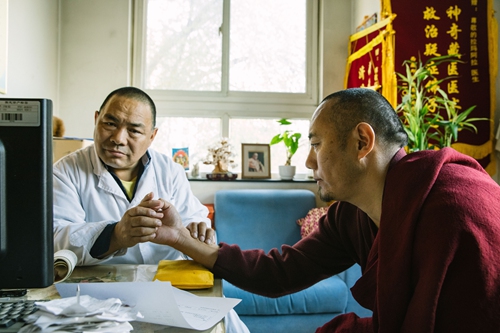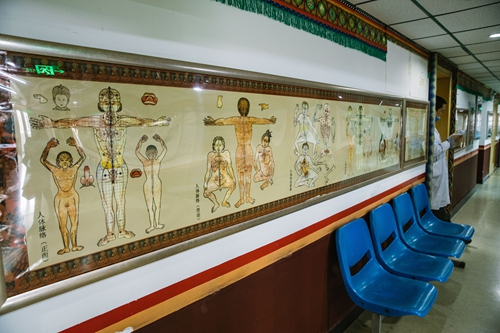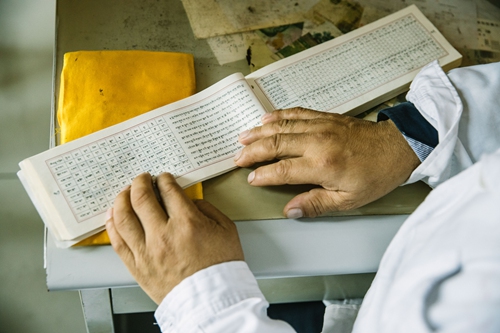HOME >> CHINA
Tibetan medical student inherits and promotes ancient heritage
By Shan Jie Source:Global Times Published: 2019/11/28 20:53:42

Tibetan doctor Lama'ala feels the pulse of a monk. Photo: Li Hao/GT
Doctor Lama'ala's consulting room is always the busiest one in the Beijing Hospital of Tibetan Medicine.
The hospital, located in Beijing's Chaoyang district, is not big, but patients arrive from all over China with big hopes Tibetan doctors can cure their illnesses.
"He extended my father's life for one year. My father suffered from lung cancer," a middle-aged man donning a sleek black leather jacket told the Global Times in his heavy Beijing accent.
Sitting on the sofa in Lama'ala's consulting room, he asked the doctor to prescribe medicine for his ailing wife. Lama'ala is not fluent in Putonghua, so his colleague Xiangjiang Duojie, a young doctor in his office, serves as his interpreter. "You need to wait for several days until you can have the medicine again," Xiangjian Duojie told the Beijing couple patiently.
After the couple left, a Tibetan Lama in a brick-red colored robe came in the consulting room. He travelled all the way from Southwest China's Tibet Autonomous Region to treat his lumbar spine problem.
The monk carried his magnetic resonance photos that were taken in another hospital.
After examining the photos, Lama'ala feels for the monk's pulse and begins the treatment plan.
Lama'ala's short build and tanned complexion are characteristic of many people from China's high plateau regions.
Some view the Tibetan doctor's work as exotic. For Lama'ala, it is heritage. A yellow-covered Tibetan calendar brochure is always by his hand. Before applying treatment, he charts the patient's birthday on the calendar to choose an auspicious date.
A patient came to his office with some dried wolf stomachs, an ingredient common in traditional Tibetan medicine, and requested Lama'ala to check them for his use.
Follow the master
Lama'ala's small consulting room was covered with scarlet silk banners inscribed with his patients' appreciation.
But right in the middle, on the window sill sits a picture of his teacher, Cuoru Cilang, a Tibetan medical master who died 15 years ago.
Lama'ala was born into a herdsmen family in Qamdo, Tibet in 1966. At the age of 16, he went to Cuoru Monastery, a 13th centery Gagyu temple, and became a monk.
"It is common in our hometown that each family would have a son to be a monk. It is for this life and next life and to expiate the sins of parents, siblings and people in this world," he said, according to a people.cn report.
Lama'ala started studying Tibetan medicine when he was 17 and continued researching for 25 years, he told the Global Times.

Medical diagrams inside the Beijing Hospital of Tibetan Medicine Photo: Li Hao/GT
"Entering a monastery is like entering a college," he explained.
Monks start from the "10 Ming Studies," a basic course containing 10 subjects such as logic, medicine, crafts, poetry, astrology and drama.
Each of them eventually chooses their own field of study according to their talents and interests.
Lama'ala often had to do chores during his first 12 years at the temple, but he considered it a process to mold a faithful and kind spirit.
In 1988, Lama'ala was arranged to serve Master Cuoru Cilang. He stayed by his side until 2014, when he accompanied his master to Beijing to treat his disease.
After his master passed away, Lama'ala became a doctor at the Beijing Hospital of Tibetan Medicine.
Lama'ala gradually gained fame with his medical skills. He is good at treating nephropathy, diabetes as well as dermatosis.
He is also one of the few Tibetan doctors who know the technology of making "zuotai," the process of Tibetan remedies to remove toxic elements in minerals.
Lama'ala has been invited to many countries to treat and give speeches on Tibetan medicine.
He has been to the US, Hungary, the Czech Republic, the UK and France. Several months ago, he visited Moscow, St. Petersburg and Irkutsk in Russia, where Tibetan medicine is gaining traction.
The doctor said that even though he lives in a big city, he still retains a monestary-style routine and reads scriptures every day.
Doctor's philosophy
The merits of Tibetan doctors are deeply influenced by the Tibetan Buddhism and doctors are respected by residents.
Lama'ala memorized the Four Medical Classics, or rgyud bzhi, in two years. The Four Medical Classics are the most important classics of Tibetan medicine compiled in the 8th century.

Lama'ala doctor reads a Tibetan calendar in the Beijing Hospital of Tibetan Medicine. Photo: Li Hao/GT
Lama'ala said that all medical systems are based in science. He also believes that some illnesses are related to the metaphysical need and scriptures to guide cures. "But the real monsters do not exist. Some illnesses are caused by psychological problems, which would need psychological treatment and relief," he noted.
He further explained that astrology is also a part of Tibetan medicine.
"Tibetan medicine see a human the same as a grass and a tree. So humans must follow the nature and life is related to the four seasons, which is related to the stars," he said. "Do the proper things at the proper time."
Tibetan doctors also must study logics and crafts. "The surgery tools in Tibetan medicine are crafted by the doctors themselves, as well as the medical Tangka. Therefore, Tibetan doctors are not only masters of medical knowledge, but also of art."
Newspaper headline: Doctor from the monastery
Posted in: SOCIETY,ENVIRONMENT